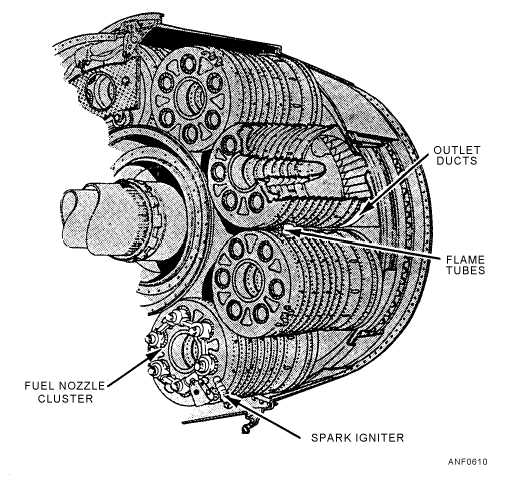COMBUSTION CHAMBER.—The efficiency
and performance of a turbine power unit depend on the
type
of
combustion
system
used.
The
basic
requirements for a satisfactory system are a high rate of
burning, minimum pressure drop, small bulk, and light
weight. The system must be consistent in operation
over a wide range of loads and altitudes, with no
tendency to flood with fuel or suffer
combustion
blowout. Combustion blowout is a flame failure, and it
is primarily a problem in high-altitude operation.
Starting must be easy and positive, both on the ground
and in the air. Combustion must be complete to avoid
formation of carbon deposits.
Fuel enters the front of the burner as an atomized
spray or in a prevaporized form. Air flows in around the
fuel nozzle and through the first row of combustion air
holes in the liner. Air near the burner nozzle stays close
to the front liner wall for cooling and cleaning
purposes. Air entering through opposing liner holes
mixes rapidly with the fuel to form a combustible
mixture. Air entering the forward section of the liner
recirculates and moves upstream against the fuel spray.
During combustion, this action permits rapid mixing
and prevents flame blowout by forming a low-velocity
stabilization zone. This zone acts as a continuous pilot
for the rest of the burner. Air entering the downstream
part of the liner provides the correct mixture for
combustion. This air also creates the intense turbulence
necessary for mixing the fuel and air and for
transferring energy from the burned to the unburned
gases.
Since an engine usually has two igniter plugs, cross
ignition tubes are necessary in the can and can-annular
types of burners. These tubes allow burning to start in
the other cans or inner liners. Axial-flow engines use
either an annular or the can-annular (fig. 6-10) type of
combustion chamber. The igniter plug is usually
located in the upstream reverse flow region of the
burner. After ignition, the flame quickly spreads to the
primary (combustion) zone. This zone contains the
correct proportion of air to completely burn the fuel. If
all the air flowing through the engine were mixed with
the fuel at this point, the mixture would be outside the
combustion
limits
for
the
fuel
normally
used.
Therefore, only about one-third to one-half of the air is
allowed to enter the combustion zone of the burner.
About 25 percent of the air actually takes part in the
combustion process.
6-6
Figure 6-10.—Can-annular combustion chamber components and arrangements.

